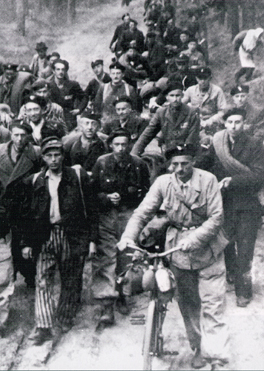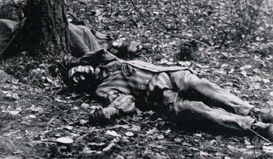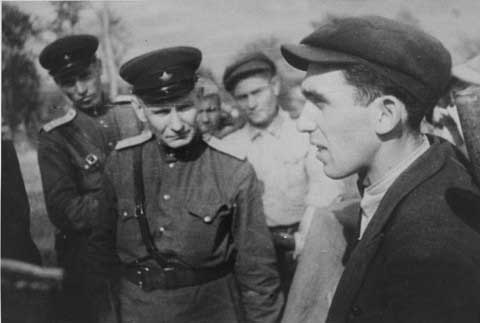Death March out of Sachsenhausen In the final days of World War II, as the Red Army of the Soviet Union approached the concentration camp at Sachsenhausen, the prisoners were evacuated, on the orders of Adolf Hitler himself. Buchenwald, which was the first major concentration camp in Germany to be discovered by the Allies, had already been liberated by the American Army on April 11, 1945. The prisoners at Buchenwald had been released by the Americans and allowed to beat 80 camp guards to death, then allowed to wreak havoc on the civilian population in nearby Weimar. Hitler was enraged when he learned that German citizens in Weimar, one of his favorite cities because it was the former home of Goethe and Schiller, had been raped or killed and their homes looted by the released inmates, after American soldiers had provided them with jeeps and weapons. On April 15, 1945, the concentration camp at Bergen-Belsen had been voluntarily turned over to the British Army after Heinrich Himmler negotiated a cease fire in the area surrounding the camp. Himmler was appalled when he learned that the British had arrested all the members of the camp staff on the same day that they took over the camp, and that they had killed some of the Hungarian soldiers assigned to guard the camp during the transition period. He was determined to evacuate all the Sachsenhausen prisoners who could still walk, along with all the SS guards, before the Russian Army arrived in Sachsenhausen. The evacuation of Sachsenhausen began in the early morning hours of April 21, 1945. Thirty-three thousand prisoners from the camp, including women and children, set off toward the northwest, while 3,000 prisoners who were too weak or sick to travel were left behind to be liberated by the Russians, according to an Information Leaflet distributed at the Memorial Site. German criminals, who were prisoners at Sachsenhausen, were involuntarily conscripted into the "camp people's unit," so that they could help the SS in guarding the political prisoners on the march; the criminals were provided with weapons, but hardly any ammunition.  Information Leaflet Number 7, which I obtained at the Memorial Site, describes the march as follows: The columns marched between 20 and 40 kilometers a day in cold wet weather and slept outdoors. In each column prisoners dragged wagons loaded with the belongings of the SS men. Since the streets were filled with refugees and army units, the columns moved forward very slowly. Following orders to kill or acting on their own initiative, SS men shot those who lagged behind or prisoners who tried to find stored potatoes and turnips to feed themselves. It is unlikely that the plan was to drive the prisoners to the Baltic Sea or as the former camp Commandant Anton Kaindl stated during the Soviet Sachsenhausen trial in 1947 "to drive them onto barges out to sea and let them sink." The SS had already notified the International Red Cross on April 19, 1945 of the upcoming evacuation, and had requested food supplies. Traveling via either Neuruppin or Rheinsberg, the columns of prisoners arrived in the vicinity of Wittstock. On April 23, 1945, more than 16,000 prisoners were concentrated into a large camp near the "Belower Woods." Other columns camped in barns in the nearby villages. While the SS camp leadership found quarters at nearby farms, the prisoners sought shelter from the cold in the woods camp in self-made dug-outs and fox-holes and they tried to abate their hunger with herbs, roots and bark. The situation did not improve until trucks which had followed the marching columns arrived loaded with food from the International Red Cross. The Red Cross delegation apparently was also able to suspend the order to shoot prisoners who were unable to continue on the march. On April 27, 1945, the director of the political department of the Sachsenhausen concentration camp officially released about 250 prisoners, almost all Germans. Due to the massive danger of an epidemic, on the following day the SS permitted an emergency hospital to be set up near the village of Grabow where prison doctors and nurses provided medical attention to more than 800 prisoners. One hundred and thirty-two of the many prisoners who died in the woods camp and in the hospital are buried at the cemetery in Grabow. By April 29, the columns left the woods camp and having traveled along different routes arrived in May in the territory between Parchim and Schwerin. At this point, the SS guards deserted the march and the prisoners were finally rescued, between May 3rd and May 6th, 1945, by soldiers of the 2nd Belorussian Front in Crivitz and Raben-Steinfeld near Schwerin and by American troops of the 7th U.S. Tank Division near Ludwigslust. On May 8, 1945, the German Army surrendered and the war was over. The total number of prisoners who died on the death march, or in the aftermath, is not mentioned in the Information Leaflet about the march. Apparently, the exact number is unknown. The Leaflet does mention that a search was conducted in the Summer of 1945, on the initiative of some of the former prisoners, to find the remains of the victims of the death march, but only a few of the dead could be found and buried.  During his testimony at the proceedings of the Soviet Military Tribunal in October 1947, Commandant Anton Kaindl testified that there were 45,000 prisoners on the death march and that 7,000 of them starved to death because there was no food to give them. After the marchers were freed by Allied troops in early May, they were housed in barracks in Schwerin, along with prisoners who had been liberated from the Ravensbrück camp for women by Russian troops. (Ravensbrück is only a few miles north of Oranienburg and is near Berlin.) Survivors of the Wöbbelin satellite camp of Neuengamme, which was liberated by American soldiers, were also brought to the hospital at Schwerin where many of them died. On May 8, 1945, the day that World War II officially ended, the prisoners, who had died after their liberation, were buried by the Americans in Schwerin with an official ceremony. Many of the prisoners who had died on the death march during the evacuation of Sachsenhausen were buried unceremoniously in mass graves at Schwerin on May 7, 1945, according to the pamphlet from the Sachsenhausen Memorial Site. A few German political prisoners, who were able to escape from the death march, returned to the Sachsenhausen concentration camp and less than a week after the liberation by Soviet troops, the former prisoners demanded that the citizens of Oranienburg be forced to visit the camp, as was done at Buchenwald and later at Dachau. But, according to the Information Leaflet, this request did not receive much of a response. By 1950, the survivors had placed boulders along the route of the death march and by 1976, two hundred signs, like the one in the photograph above, had been erected along the four main routes of the march. Since the mid-1970ies, annual memorial walks have been made along the route of the death march. The museum at Sachsenhausen has a special exhibit about the death march and the camp in the Belower Woods. There is also a separate Museum, established by the Communist East German government (the GDR), called the "Museum of the Death March" which opened on April 21, 1981, the 36th anniversary of the beginning of he march, in the Belower Woods near Wittstock. The museum is a 10-minute walk from the rest stop right behind the Wittstock exit on A19, the Rostock-Berlin highway, as you are going in the direction of Rostock. To reach the museum, take Wittstock-Röbel street and follow the signs. A pillar with a red triangle, the symbol of the Communist political prisoners, was erected in 1975 and a memorial grove was established in the Belower Woods.  After the prisoners of Sachsenhausen were evacuated, the camp was liberated on April 27, 1945 by units of the 1st Belorussian Front of the Red Army of the Soviet Union and units of the 1st Polish Army of the Soviet Union. These two Armies were fighting the German Army around Oranienburg and were not on a mission to liberate the prison camp. They arrived separately and independently of each other and discovered the 3,000 sick and weak prisoners who had been left behind.  Polish military doctors took over the care of the sick prisoners until Soviet nurses arrived. In spite of all the medical attention given by the Soviet Army, at least 300 of the liberated prisoners died in the Sachsenhausen infirmary before it was closed in the Summer of 1945. They were buried in six unmarked mass graves along the wall around the camp. The graves were forgotten and were not rediscovered until 1995. They are now located in the area where visitors enter the Memorial Site. Information Leaflet Number 7 from the Sachsenhausen Memorial Site also tells about Scandinavian prisoners in the Sachsenhausen camp who were saved through an operation called "Weisse Busse" (white buses). During the period between March 15th and March 29, 1945, seven transports brought 2,176 Swedish, Danish and Norwegian prisoners to an area in the Neuengamme concentration camp which was under Swedish control. From there, the prisoners were transported a short time later, via Denmark, to Sweden. These prisoners had been released on the orders of Reichsführer-SS Heinrich Himmler, the head of all the concentration camps, after negotiations with Count Folke Bernadotte, the vice-president of the Swedish Red Cross. Himmler wanted to negotiate a surrender to the Americans, but not to the Soviet Union, and he was trying to create good will by releasing concentration camp prisoners. Trial of Commandant Anton Kaindl and 15 othersTable of ContentsHome |